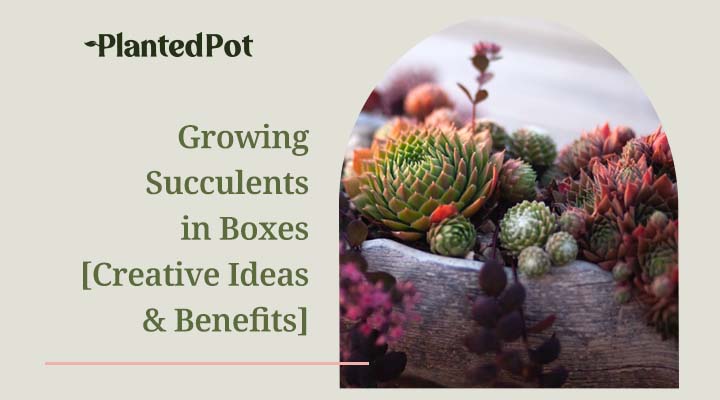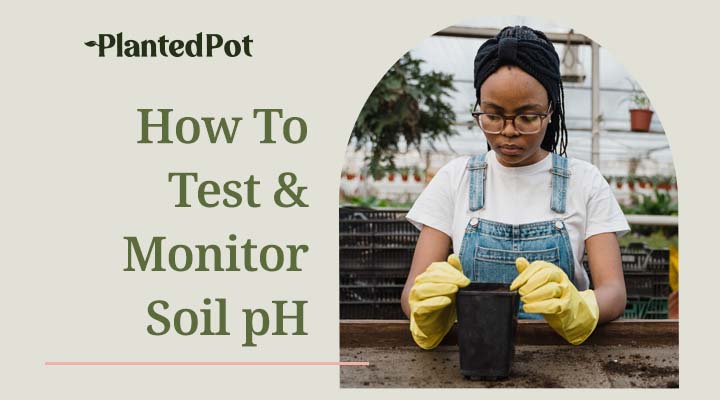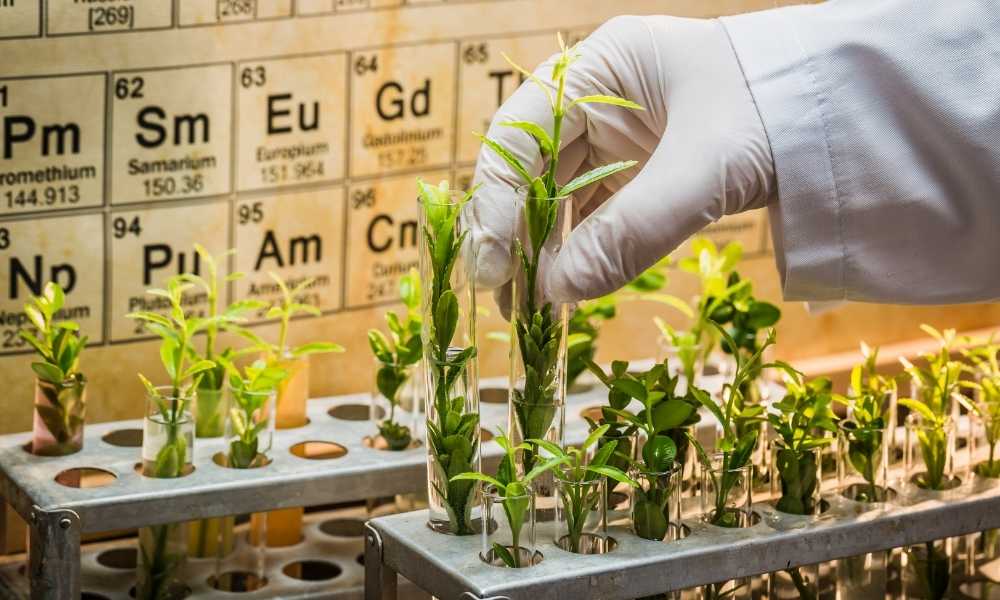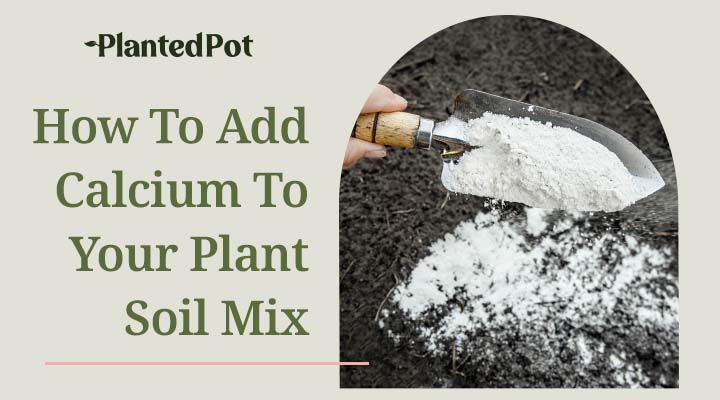
How to Test Soil pH [Tips & Tricks for Monitoring Your Plant’s Soil]
Home / How to Test Soil pH [Tips & Tricks for Monitoring Your Plant’s Soil]

How to Test Soil pH [Tips & Tricks for Monitoring Your Plant’s Soil]
- Olivia Richman
- August 2, 2021
- 1:47 pm
- No Comments
Having an outdoor garden is an amazing escape. It’s a relaxing location to fully focus and calm your mind. It’s a place to breathe in one-of-a-kind scents and grow your own fruits, vegetables, and herbs. But outdoor gardens do take a bit of work if you want to see stunning results. That’s why plant lovers need to know how to test soil pH.
While most plants are quite durable and versatile, there are a few things they need to thrive. One of those things is soil with a healthy pH level. You will want a certain pH level for the plants in your garden. But what is that pH level? How does soil ph testing work? And how do you change it after a soil ph test? We have everything you want to know about soil pH test and why it’s important right here!
What is pH?
pH is a scale used in chemistry to find the exact acidity or basicity in soil, water, and other solutions. Acids and bases are two categories of corrosive substances. A soil sample with a pH value between zero and seven on the scale is acidic while a pH value between seven to 14 is a base.

Why Test and Monitor Soil pH?
The pH level in your soil will determine how well certain plants can grow. Each plant has their own specific pH level preference so it’s important to test your soil, specifically for pH and acidic or alkaline compounds, to determine what plants are best suited for your yard.
You should also monitor your soil’s pH to keep your plants healthy and thriving. The pH level of your soil allows nutrients to be freely available for plants to take in. So you want to always ensure that your plants are getting what they need to survive in your yard or at home. Here are some examples:
Acidic Soil (pH 5.0 to 5.5)
- Azaleas
- Rhododendrons
- Blueberries
- Conifers
Slightly Acidic Soil (pH 5.8 to 6.5)
- Vegetables
- Grasses
- Ornamental plants
Often, soil pH values that are above or below these ranges will not have enough nutrients to lead to vigorous growth. You may notice your plants growing slowly. Some might even start to die.
Can You Adjust Your pH?
Yes! There are many environmental and behavioral factors that can impact your soil’s pH level. This includes the types of rocks in the soil, the amount of ran your yard gets, and if you use fertilizer or not. Even though some of these factors are not in your complete control, there are things you can do to adjust the pH level of your garden.
How Do You Adjust Your pH?
If you’re looking to increase your soil’s pH level by making it less acidic, try applying a material that contains a form of lime. The most commonly used material is ground agricultural limestone (the finer the better). The amount of lime you use depends on the texture of the soil as well as the contents of the soil and your choice of plants.
The four main ground limestone products are:
- Pulverized
- Granular
- Pelletized
- Hydrated
Limestone should be added in the fall or winter. It should be applied two or three months before you start planting. This allows it to neutralize acidity. Before applying the limestone, make sure that you have watered the soil and it’s moist. This is essential for the reaction to occur.
How Raise the Soil’s pH Level With Wood Ashes
Another way to raise the soil’s pH level is with wood ashes. Wood ashes have a high amount of potassium and calcium, as well as small amounts of phosphate and boron. Gardeners will say wood ashes aren’t as impactful as limestone, but they can still drastically raise the pH value of your soil. Spread a thin layer during the winter and incorporate the wood ashes into the soil during the spring. Don’t use a large number of wood ashes because excessively high pH values will lead to a lack of nutrients.
Plant experts and experienced gardeners also have tricks for decreasing your soil’s pH. Consider using aluminum sulfate or sulfur. Both of these can be found at most garden supply centers. Aluminum sulfate changes the soil’s pH right away due to the acidity it produces as soon as it dissolves. Sulfer will need a bit more time for the conversion process to occur. The speed it works is impacted by your soil’s moisture, temperature, and the present bacteria. It can sometimes take a few months if the conditions of your garden aren’t ideal.
Work both of these materials into the soil after they are applied to make them effective. Whether you apply sulfur or aluminum sulfate, make sure you wash off your plant’s leaves immediately after the application. They can both lead to burnt leaves. You don’t want to apply to either of them for this reason.
Check out how much aluminum sulfate or sulfur you’ll need to use depending on your soil’s current pH level and your desired pH level.
How to Test Soil pH
Even though pH levels can seem sciency and confusing, it’s actually pretty easy to test your soil’s pH level! With a simple test kit, it’s easier than ever to run a soil test right at home. Here are three simple and accurate methods.
Simple Method
This is the most popular way to monitor your soil’s pH level because it’s so easy to do! But a lot of plant people say it’s the least accurate. Still, you’ll be able to know if your soil is acidic, alkaline, or neutral.
Most of the things you need are probably already in your kitchen! Here is what you need:
- White vinegar
- Baking soda
- Tablespoon
- Cups for holding the soil and liquid
- Soil samples
- Distilled water (or reverse osmosis)
Here is what you do to get your soil’s pH level:
- Take a few samples at different spots throughout your garden. Just make sure they are the same depth.
- Put in two tablespoons of soil into two different containers.
- Put half a cup of white vinegar into the containers and pay attention to the reaction of the vinegar hitting the soil. Fizzing? That’s alkaline soil (7.0 – 8.0 pH level). If you don’t hear fizzling, there are a few more steps.
- Add some water to the other container until the soil is wet.
- Take half a cup of baking soda and add it to the container. Is there fizzing? If so, your soil’s pH level is neutral (about 7.0).
Slurry Method
This is known to be one of the most accurate tests you can do if you don’t have a specialized pH meter. Just make sure you have a standard pH meter. Calibrate it first. You’ll also need:
- Distilled water (or reverse osmosis)
- Soil samples
- Container for holding the samples
- Kitchen scale
And here is how to conduct this test!
- Start by taking soil samples. Make sure they’re from different points within your garden but the same depth each time.
- Add about 1 to 1.5 ml of distilled water for every gram of soil. This means 50 grams of soil would need 50 to 75 ml of distilled water.
- Stir the soil and water together for just a few seconds.
- Let the mixture sit for at least an hour.
- After the timer goes off, stir the mixture again and then stick in your pH meter.
Direct Testing
Direct testing is another popular way to find out your soil’s pH level. While you don’t need soil samples, it’s also not the most accurate method out there. You can only test the soil as deep as your pH meter can go into your garden. Here is what you need for this simple test:
- Ruler to poke holes in the soil
- Distilled water (or reverse osmosis)
- pH meter
As you can see, it takes a lot less to get started with direct testing. Here are the steps!
- Use your ruler to poke holes in the ground. Pick different points throughout the garden but make sure it’s the same depth each time.
- Add distilled water into the holes to dampen it. Make sure the soil isn’t completely saturated.
- Insert your pH meter and allow it to stabilize.
What Are the Optimal Soil pH Ranges?
The pH level you want really depends on the plants in your garden. But most home gardens range from 6.0 to 7.0, with an average of 6.5. This is the slightly acidic to neutral range. There are a few plants, however, that prefer more acidity (Blueberries, Azaleas) and some that prefer slightly alkaline (Ferns, Asparagus).
What Can Affect Soil pH?
The pH level of your soil depends on a lot of factors, some that are environmental and others that are affected by your gardening habits. Here are some of the most common things that affect the soil’s pH level.
Climate & Weather
Temperature and rainfall have a major impact on the pH level of your soil. Warm, humid weather will decrease soil pH over time. This is due to “leaching,” meaning the loss of water-soluble plant nutrients in the soil.
Plants
Each plant needs its own pH level to thrive. But did you know that the plants in your garden can also impact the pH level of the soil? Plants change pH levels by metabolizing chemicals, absorbing chemicals, and absorbing minerals from water.
Plants that absorb certain chemicals will prevent the pH from dropping. Meanwhile, plants that absorb minerals from the water (like calcium) reduce the “buffering” capacity of water, lowering the pH level.
Soil Type
The materials and elements in your soil can change pH levels. If your soil was developed from basic rocks, you will notice higher pH values. Acid rocks will have lower pH levels.
Related: Types of Soil: Choosing the Right Mix For Your Best Garden
Fertilizer
The type of fertilizer you use will impact the soil’s pH level. Nitrate-based fertilizers will increase the soil’s pH level. Ammonium or urea-based fertilizers can reduce the soil’s pH level. This occurs because of how plants react to the fertilizer.

What Happens if Soil pH is Too Low?
For your plants to thrive properly, you need to keep track of your soil’s pH level. A pH reading that is too high or too low will make your soil-less healthy, affecting the plant’s growth.
When soil pH is too low on the scale, that means the soil is very acidic. Most plants won’t tolerate this. And many will even die due to a lack of calcium. You’ll notice scorched leaf tips. Thus, without treatment, the plant will end up losing leaves and then dying.
Final Thoughts – How to Test Soil pH
You can’t just plant your flowers and fruits and expect them to thrive without any help from you. Outdoor plants need a bit of love and plant care to remain healthy, beautiful and blooming. One of the things you should regularly do is a test for the soil’s pH level.
Luckily, testing your soil’s pH level is super easy. There are very few things you need to get started and the processes are all fast! You’ll know your garden’s pH level in no time. From there, there are some easy ways to change the pH level to better suit your plant. You should always look at the desired pH level for the plants you choose so you can make sure they will thrive in your garden!



